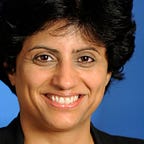Chase a pilot.
A pilot is a real-world classroom.
Within a year of starting YinzCam, I scrapped the idea for the company.
I did a pilot. I got a reality check.
I saw that I didn’t have a company on my hands.
And, I pivoted.
My pilot story.
I became a rabid hockey fan after moving to Pittsburgh (there’s something in our water), to become a professor at Carnegie Mellon. Live hockey is priceless. It’s riveting, it’s beautiful, it’s pure adrenalin. When I watched my Pittsburgh Penguins at the arena from my nose-bleed seats, I couldn’t see the fight, the goal, the save, because the tall guy in front of me cut off my view of the ice. All I wanted to do was to see the action. That’s all. As a fan, I wanted to sit at my seat, and to be in control of how I experienced the game. I wanted to watch the live action on my phone, from every possible camera angle that you could throw at me.
I was in love with the idea.
I wanted it as a fan.
I wanted it for me.
The Penguins (bless them) were generous to this Indian-born, Zambian-raised, non-hockey-playing, hockey-obsessed fan. I still live in disbelief that they let me pilot this idea at their games. 14 years later, I am still in shock that a multiple-Stanley Cup-winning NHL team let me “play” at their arena for all 40 games of a season. So, we went to pilot — 40 games to see if fans would take to the idea.
Well, the good news was that fans loved the idea.
But, how many fans?
This is where product-market fit came in. I did the math. I learned about the size of the addressable market. I learned the business constraints.
The idea of fans watching live replays from multiple camera angles would not translate to the fan at home. Broadcast rights meant that live cameras inside an arena had to be constrained to run over the in-arena Wi-Fi. The market (at best) for what we had built, would be the total number of fans inside a stadium with Wi-Fi-enabled phones.
At the time, Wi-Fi penetration on phones was at a whopping 20% (grimace). So, my market was 20% of 20,000 in-arena hockey fans, for 40 games in a season. Tops. Pretty encouraging for a startup, right? 🤣
On the other hand, the TV audience for a hockey game could be north of 500,000 on-the-couch fans, who just might engage if the right product were put in front of them.
And, so, we pivoted.
We knew we wanted something mobile (check), we had a novel idea that would get sponsors to listen (the hook), we wanted to reach the largest market possible (the couch fan and the in-venue fan), and we didn’t want to run afoul of broadcast rights.
We went from a company that did multi-camera replays (for in-venue fans alone) to a company that built the official mobile app (for both in-venue fans and couch fans) for a team.
The pilot was my real-world classroom.
The games were my lectures.
The fans were my teachers.
What I learned from the pilot was how to test an idea with a real audience, what the brick walls (broadcast rights) were, what revenue streams (e.g., sponsorship) existed in the industry, and what challenges (e.g., scaling) we would face to start a company.
Because of the pilot, I found a company, and I founded a company.
A pilot is data.
A pilot is like a runner signing up for a race. You can run over the weekends, or on your own, but putting yourself out there on the starting line is facing your fears, sharpening your focus, and running in front of others. It tells you what you are made of.
A pilot is the first time that a product escapes the lab and faces real users.
A pilot is your worst fears coming true.
A pilot is your wildest dreams coming true.
A pilot can tell you that you are on course.
A pilot can tell you that you are off course.
A pilot is a reality check.
A pilot can be validation.
A pilot can be adrenalin.
A pilot can be fear.
A pilot can be heartbreak.
A pilot is data.
You can fall in love with the idea, but a pilot helps to validate if there is a company or not.
When you pilot something with real users, you put your idea to the test. You face real-world conditions that will reveal your flawed assumptions and your idea’s weaknesses. You learn, first-hand, the challenges of product scale, product deployment, and user adoption. You learn what you ought to focus on, and what is just a distraction. You learn what is cake and what is frosting. You learn your possible business models.
A pilot helps you evaluate what real users think.
A pilot helps you determine a business model.
A pilot helps you to discover product-market fit.
A pilot tells you if you have a product on your hands.
A pilot tells you if you have a company on your hands.
So, go chase a pilot.
